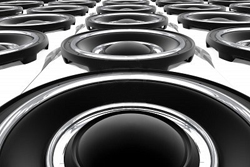
Mid-range drivers cover the middle portion of the spectrum and fall between woofers and tweeters in most of their characteristics including size and moving mass.
Another entirely different kind of loudspeaker is the musical instrument speaker, such as those in electric guitar amplifiers.
Unlike a professional audio loudspeaker, which is intended to reproduce the sound with as little distortion as possible, a loudspeaker for electric guitar is intended to introduce distortion.
All musical instruments produce sound full of harmonics at many different frequencies. That is what gives them their character. A guitar loudspeaker is really part of the instrument, not just a sound reproducer; but that is a story for another day.
Some less common types of loudspeakers include ribbon drivers, which have a flexible plastic diaphragm with an etched conductor printed on the surface. The diaphragm and its integral conductor are positioned in a magnetic field so that the diaphragm moves when current flows in the conductor.
Ribbons are a relatively simple construction and can sound excellent as mid-range and high-frequency drivers, but can be more expensive due to the large amount of permanent magnet material required to get a sufficiently strong magnetic field in the wide gap.
Piezoelectric drivers use wafers of a ceramic material that has the characteristic of bending or distorting when an electric voltage is applied to it. These are typically low power handling devices, but cost very little to manufacture and can be used with very simple, low-cost crossovers or even with no crossover at all.
Electrostatic loudspeakers use the principal that like charges repel and opposite charges attract. They consist of a pair of perforated metal plates separated by an air space and a plastic sheet. A high voltage differential is applied across the plates creating an electric field between them in the region occupied by the plastic sheet.
If an electric charge is applied to the plastic sheet, it will be pushed away from the plate with like charge and pulled toward the plate with opposite charge.
Despite the apparent simplicity, electrostatic loudspeakers are expensive to manufacture and the maximum sound pressure possible is insufficient for professional sound reinforcement, so they are limited to high-end home hi-fi applications.
Tactile transducers aren’t really loudspeakers per se as their intent is not to move the air, but rather to move something solid like a floor, stage, or piece of furniture. These devices operate by moving relatively heavy masses, such as steel cylinders, which in turn vibrate whatever solid structure to which the transducer is attached.
Because they move such a heavy mass they require fairly powerful amplifiers. They are important to reproducing frequencies below human hearing, such as the thump of approaching dinosaurs in Jurassic Park. Watching such movies with the aid of tactile transducers can be a much more exciting experience.
There are even more obscure types of loudspeakers and components, but the ones noted here have had at least some moderate commercial success.
Rob Gault works with Eminence Loudspeakers, based in Kentucky.


